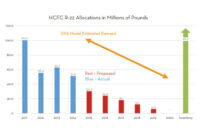
|
| Peter Dinnage |
Editor’s Note: Europe is now only a year away from a total ban on R-22 and other hydrochlorofluorocarbons (HCFCs). And Peter Dinnage warns, the HVAC industry has to act fast to get the message across to customers.
Reclamation Proclamation
Although the use of virgin HCFCs was banned four years ago, many have kept their R-22 equipment running by using reclaimed R-22 originating from other plants that have already been replaced or converted. The high cost of reclaimed R-22 — often twice the price of replacement refrigerants — has not deterred its continued use, but in just under 12 months, it will be illegal to top up any refrigeration, air conditioning, or heat pump system with this or any other HCFC. The time for procrastination is over as this pressing issue is well and truly upon us.
There cannot be anyone out there unaware of the ban, it has been well publicized over the last few years, by the trade press and suppliers alike, whilst contractors have a plethora of quotes that have been resubmitted at various intervals covering the different options available.
The easy option is to replace what is now aging plant with new equipment, and to reap the benefits of better energy efficiency and improved design that comes with the newer technology. However, for some, this is also a very costly option, especially those sectors where margins and profit are tight and future business may not be guaranteed for the payback period.
For new equipment in the industrial sector, ammonia and glycol systems are popular choices, as long as local regulations allow the use of ammonia. Meanwhile, for air conditioning, R-410A is the refrigerant of choice, along with R-407C for chillers.
Many supermarkets have used CO2 in new stores, whilst companies who would have turned to R-404A in new equipment for refrigeration are now opting for R-407F as it has a much lower global warming potential (GWP) and is approved by the leading compressor manufacturers.
It would be very unwise to replace aging R-22 systems with new equipment running on R-404A, only to find that such high GWP refrigerants are banned in the new F-gas regulations — as has been proposed.
Even if the choice of refrigerant has been made, it is not all plain sailing for installations, since rumors abound that many of the reputable contractors have full or nearly full order books for new equipment installs during 2014 and lead times on new equipment are extending. For those who don’t have the capital expenditure approved in the budget, and orders already placed, it may quickly become 2015 before new equipment could be installed. So, demand for reclaimed R-22, just before the Jan. 1, 2015 phaseout may be higher than anticipated.
Some major supermarkets have urged their food suppliers to ensure their equipment is free of HCFCs before the end of the year, so they can ensure continuity of supply.
Insurance coverage continues to be a further problem potentially looming for those still with R-22 equipment in 2015. We have heard that many policies will not cover any loss of product or service as a consequence of losing cooling due to a leak from a system where R-22 is the refrigerant.
Landlords with empty sites and R-22 equipment have already found they cannot rent or lease anything that still has equipment with R-22 in the refrigeration or air conditioning systems.
Those currently planning to put off the decision as long as possible — running their plant into 2015 by topping it up with R-22 before deadline day and then banking on it running for a few more months — should note that refrigerant reclaimers won’t want to be reprocessing any more R-22 than they need during 2014.
Any R-22 left in equipment in 2015, when it is eventually removed, will need to be disposed of in a safe manner complying with legislation. That process won’t come cheap.
The good news is that over the last 15 years, a lot of R-22 systems have been converted to alternative refrigerants with great success, although there is no one-size-fits-all solution.
For air conditioning systems, R-417A, R-422D, R-407C, and R-438A have all proved successful as long as the supplier conversion guidelines are followed and the equipment doesn’t have existing operational issues.
Across Europe, R-422D has been the favorite for direct-expansion refrigeration applications, although R-438A is now seen to be the closest match for R-22 across a whole range of applications.
Larger equipment with flooded evaporators, pump circulation, and hybrid systems can be converted, with some drop-off in performance. If the pressure rating and condenser size can accommodate R-507, it also remains an option. However, some of the larger flooded or centrifugal systems cannot be converted, or will give significantly reduced performance — although in some cases that may still be preferable to having no operational plant at all.
For those unsure of what to use, there is plenty of good advice available from knowledgeable companies, who can help select which refrigerant to choose for each application.
Plenty of food for thought, but little time to ponder. Now is the time to act and replace R-22 before it is at an end.
Publication date: 3/3/2014
Want more HVAC industry news and information? Join The NEWS on Facebook, Twitter, and LinkedIn today!










